19. A COLD WAR DEVELOPS

POST-WAR EUROPE
CONTENTS
 Truman takes on early global challenges Truman takes on early global challenges
 The mounting sense of a Soviet or The mounting sense of a Soviet or
Stalinist danger
 Crisis in Greece and Turkey ... and the Crisis in Greece and Turkey ... and the
"Truman Doctrine"
 Mounting problems in Western Europe ... Mounting problems in Western Europe ...
and the Marshall Plan
 The Communist coup in Czechoslovakia The Communist coup in Czechoslovakia
 Helping Tito move out from under Helping Tito move out from under
Stalin's control
 The Berlin Blockade (June 1948 – May The Berlin Blockade (June 1948 – May
1949)
 The ineffectiveness of the UN ... and the The ineffectiveness of the UN ... and the
Creation of NATO
The textual material on this webpage is drawn directly from my work
America – The Covenant Nation © 2021, Volume Two, pages 56-69.
TRUMAN TAKES ON EARLY GLOBAL CHALLENGES |
|
As we have already noted, Truman was very much
like Churchill in his suspicions about unchecked power. Arriving
abruptly on the diplomatic scene after Roosevelt's death in early 1945,
with not a lot of prepping (while serving only briefly as vice
president, he had been privy to almost none of the military-diplomatic
proceedings going on within Roosevelt's Administration), he had at
first wanted to trust Stalin. But he soon realized that this was not
going to be possible, given the position in which the Russians found
themselves in Eastern Europe, with the Red Army in occupation of nearly
all of the Eastern half of Europe.
For Soviet Russia's Stalin, the matter of
what happened after Germany was defeated was quite simple: the Soviet
Red Army was in occupation of nearly all of Eastern Europe – offering
Stalin and his people a sense of security that they had never felt
since Russia began opening up to Western culture in the 1500s. There
was no way, despite the promises he had made to Roosevelt to hold free
elections throughout Eastern Europe, that Stalin (who personally was
massively paranoid anyway) was going to allow any but the most
Moscow-dependent – actually Stalin-dependent – regimes to be elected to
high office in those countries that his Red Army at that point
controlled directly. In one country after another Stalinist puppets
would soon appear at the head of each of the new governments of Eastern
Europe.
Truman could understand this Russian
desire to keep as much land buffer between itself and the European
West, which had been the source of endless attacks on Mother Russia,
from either the French, the Germans or even the Poles. But Truman
understood also that there was more than just a national security
concern moving Stalin. Stalin had bigger dreams, to bring all the
civilized world under a Godless International Communism directed from
Moscow. Thus Truman was quick to realize that the agreements at Yalta
were largely meaningless. Power – not promise – would be the rule of
the day in Europe.
But convincing the American people of the
dangers posed by an unchecked Soviet Union would be very difficult.
During the war the American propaganda machine had built up in the
American mind the closeness of America's special relationship with
Uncle Joe Stalin. To convince the Americans now to take a firm stand
against Stalin and his expansionist plans in Europe (given also the
American dream at this point of putting all thoughts of war completely
behind them) would be a Herculean task. Also, Americans were exhausted
and looked forward greatly to getting their boys back home and
returning things to normal in America as fast as possible.
Tensions had arisen at the end of the war
over the Soviet entrenchment in Iran. During the war the Americans had
been transporting military supplies to Russia across Iran, to the
distress of the Iranian Shah (king) who was a big Hitler supporter –
and who because of it subsequently got removed from power by an
occupying Russian and American military presence there. There was
however an agreement between the Americans and Russians that this would
be merely a temporary move and that full sovereignty would be restored
to Iran after the war. However, as the war appeared to be finally
coming to an end, the Soviets made a move to set up a
Communist-governed Azerbaijan Republic in the northwestern part of
Iran, an obvious move to leave a permanent Russian presence in the
area. Such a position would give the Soviets not only easy access to
the Persian Gulf and beyond that the Indian Ocean (such a warm-water
port had long been desired by the Russians) but it would also put
Soviet Russia in a position to dominate the major part of the oil flow
out of the Persian Gulf that industrial Western Europe depended on.
Truman was quick to see the dangers posed by this move on Stalin's
part. Truman consequently took the matter to the new United Nations
Security Council, putting such pressure on Stalin that the Russians
pulled out of Iran in early 1946 and Iranian troops moved in to retake
the territory.
But it would be the last time that the
Soviets would back down in the face of a Security Council decision
going against them. The Soviets would soon become well-known for their
ready use of the power reserved to the Big Five (the Permanent Members
America, Britain, France, Russia and China) to veto any Security
Council decision they disliked. From this point on, the hope that
people had that this new United Nations Organization might be a vital
support to world peace was now dead, as dead as a similar hope that had
died with the post-Great-War League of Nations. Big Power tempers were
rising fast – and subsequent crises would be dealt with in direct
diplomacy among these powers, rather than through the UN.
THE MOUNTING SENSE
OF A SOVIET OR STALINIST DANGER |
|
Churchill's warning about an Iron Curtain falling across Europe
In March of 1946 Churchill (who at the time was largely
unemployed politically thanks to the British voters) accompanied Truman
to his native Missouri to receive an honorary degree from Westminster
College. Here he delivered a speech, acknowledging the global
responsibility that had now fallen on American shoulders.
What Churchill had to say on this matter
would actually come to shock America – though certainly not Truman!
Churchill pointed out that, thanks to Soviet control, an "Iron Curtain"
had fallen across the middle of Europe, stretching from the Baltic Sea
in the North to the Adriatic Sea in the South. And that behind that
curtain, in the Soviet sphere of influence, were the numerous cities
and peoples of Eastern Europe. In these societies, small Communist
parties had succeeded, thanks to Moscow’s increasing control, in
gaining such power as to be able to obtain totalitarian control over
these cities and peoples.
He also raised the issue of exactly how
this situation should be met – especially by the Americans, on whom so
much responsibility for the welfare of the civilized world had fallen,
reminding the Americans that the Russians admired strength and despised
weakness and, although they did not exactly want war, they were
certainly desiring the expansion of their power and the influence of
their doctrines.
As he had done with his own people during
the dark days of World War Two, he was calling now on America to take
up the challenge facing the world. For if the West (under American
leadership) did not act now in a show of strength, it would clearly be
dragged into war a third time in the 20th century. America and Britain
needed to stand together to block Stalin’s aggressions.
At the time, Churchill’s speech was received very negatively, not only
by Stalin (of course!) but also by the American news media. Churchill
was accused by numerous Americans of trying to stir up trouble between
Russia and America, of grandstanding in order to bring himself back to
political prominence (the same accusation made about him during the
1930s when he was trying to warn Britain of the dangers of Hitler’s
rise to power in Germany).
But America would soon come to
acknowledge the danger Churchill had been describing, using his term
"Iron Curtain" as a key part of the vocabulary describing a rising
East-West "Cold War."
For the time being, Truman had to go slow
in getting America back in the business of global affairs. He
personally was viewed widely by Americans simply as an accidental
occupant of the White House, possessing no serious presidential stature
before the American people. But he, with Churchill, understood that if
America did not step up to the responsibilities laid at its feet
because of the way the recent war turned out, the world would soon
enough be facing a problem as big as the one Germany and Japan had just
posed. He needed to stir America to action – though very carefully.
Actually whereas the US State Department
was still caught up in its dream of friendship with the Soviets, one of
their members posted in Kiev, George F. Kennan, answered a request by
the US Treasury Department to explain why the Soviets were not planning
to work with the new World Bank (IBRD) and the International Monetary
Fund (IMF). In his Long Telegram
(February 1946) Kennan described in detail the Soviet anti-capitalist
(and Russian nationalist) mindset, and called for the "firm and
vigilant containment of Russian expansive tendencies."
The report soon became the basis for a
larger analytical study of Soviet Russian goals and strategies
(September 1946), intended for the president's eyes only. But the
Kennan report itself was so clear in its analysis and call for a
strategic response that it was published in the July 1947 edition of Foreign Affairs
under the authorship of "X." It had the effect not only of helping to
awaken America to the need for vigilance against Soviet aggression but
it also gave the resultant US policy its identifying label:
"Containment" (of Communism).
|
Things begin to stir with
Churchill's "Iron Curtain Speech" delivered to Americans in 1946
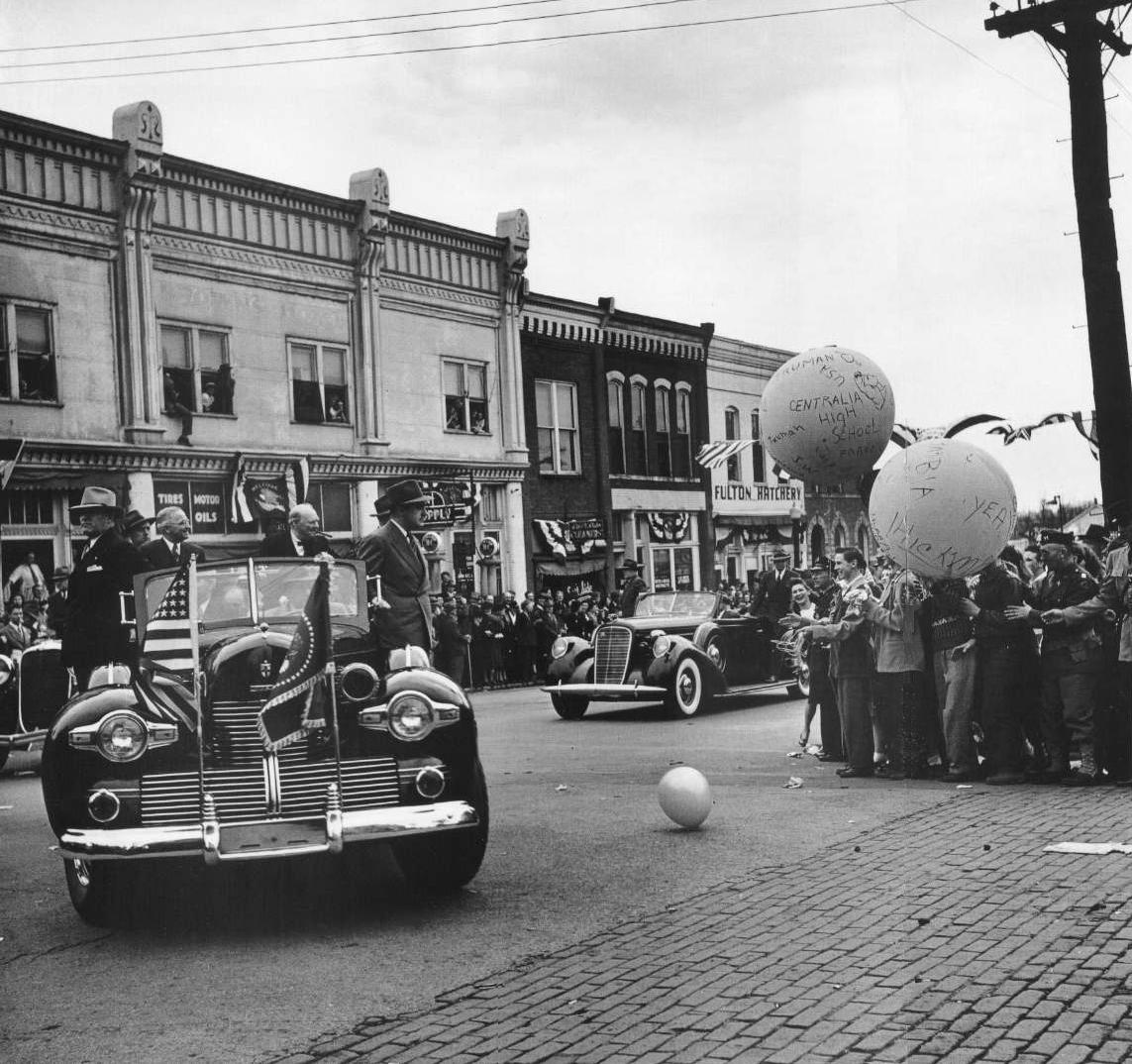
President Truman and former
British PM Churchill arriving in Fulton, Missouri – March 5, 1946
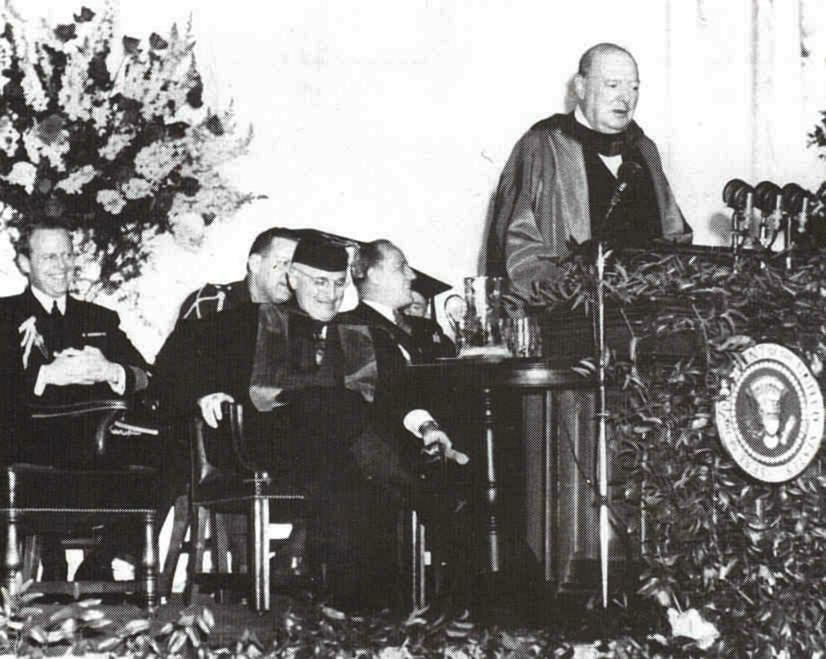 Winston Churchill delivering
his "Iron Curtain Speech" at Westminster College,
Winston Churchill delivering
his "Iron Curtain Speech" at Westminster College,
Fulton, Mo. – March 5,
1946
| "From Stettin in the
Baltic to Trieste
in the Adriatic an "iron curtain" has descended across the Continent. Behind
that line lie all the capitals of the ancient states of Central and Eastern
Europe. Warsaw, Berlin, Prague, Vienna, Budapest, Belgrade, Bucharest and
Sofia; all these famous cities and the populations around them lie in what
I must call the Soviet sphere, and all are subject, in one form or another,
not only to Soviet influence but to a very high and in some cases increasing
measure of control from Moscow." |
American diplomacy at the
time was well served by a number of very capable
and highly experienced "Wise Men"
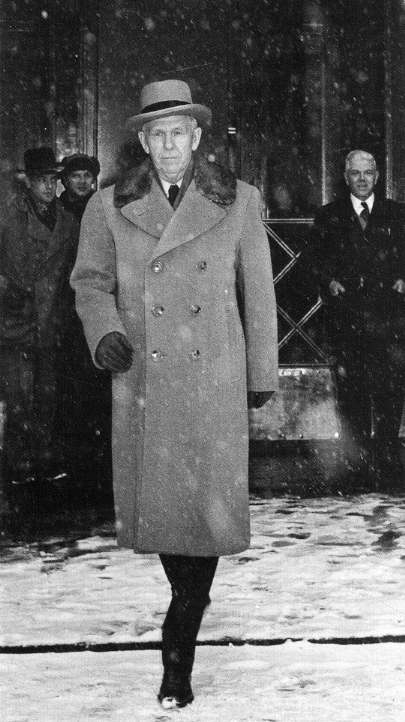 Former General, now US Secretary
of State George Marshall
Former General, now US Secretary
of State George Marshall
Also part of the Truman "Wise
Men"
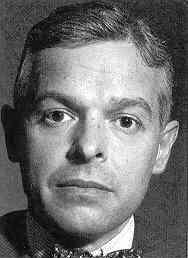
Paul Nitze
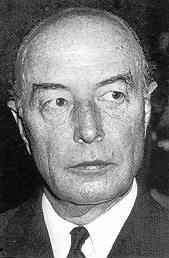
Robert Lovett
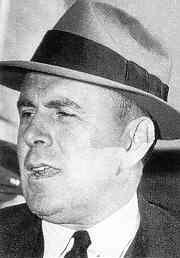
John McCloy
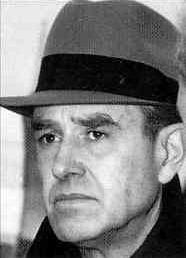
Averell Harriman
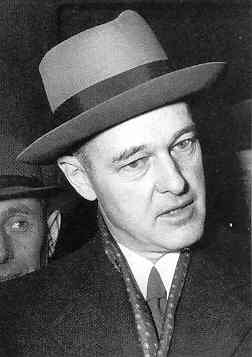 US diplomat George Kennan
who in his "Long Telegram" of 1946
US diplomat George Kennan
who in his "Long Telegram" of 1946
advocated "containment" of an expansive
Soviet Communism
This document,
originally
intended as a briefing paper for Secretary of the Navy Forrestal, was published
in the July
1947 edition of Foreign Affairs under the authorship of "X"
-
which was quickly traced
back to Kennan. But the article clarified the fact that indeed America
was headed for a 'Cold War' with Russia. |
CRISIS IN GREECE AND TURKEY
... AND THE TRUMAN DOCTRINE |
|
Crisis and Greece and Turkey
A major problem was brewing at the eastern end of
the Mediterranean, at Greece and Turkey. Failure to secure a path
to the high seas across Iran brought Stalin to redirect his focus on
gaining control of the Aegean Sea, bordered by Greece on the West and
Turkey on the East. Such control would give his navy based in the Black
Sea free access to the Eastern Mediterranean, and also a dominant
position just above the Suez Canal, through which nearly all the trade
between Asia and Europe passed. But the difference here was that the
Russian troops (as elsewhere in Eastern Europe) were not in direct
occupation of either Greece or Turkey. Stalin instead would have to
work through local Communist organizations, which received direct
orders from Stalin but did not enjoy the backing of Stalin's Red Army
in implementing those orders.
Over the previous century (since the
mid-1800s) the Turks had looked to the British for help in warding off
Russian expansionist instincts. But by 1947 the British had backed off
both militarily and financially in their assistance to the Turks.
Churchill, still out of power, was hoping that America would now take
up that role.
The Greek situation was a bit different.
In Greece it was more the case of the Yugoslavian rather than the
Russian Communists that were the immediate source of Greece's problems.
Yugoslavia, under the presidency of the Communist leader, Marshal
Josip Broz Tito, was sending financial and military aid next door (to
the south of Yugoslavia) to the Greek Communist Party, which was trying
to overthrow the Greek government elected in 1946. Here too the British
had traditionally been the guarantor of Greek political stability. But
by early 1947 Atlee's British Government was abandoning the traditional
British role in Greece as well as Turkey – and everywhere else, for
that matter. Again, Churchill urged Truman to take up Britain's
traditional role of stabilizing the entire region (uncomfortably close
to Britain's vital link to Asia through the Suez Canal). Truman
understood clearly the dynamics of the situation.
Consequently, in March of 1947 Truman
went before Congress to request financial and technical military
assistance to the Turks and Greeks. He specified only a general threat
to the independence of these countries by both outside powers and
domestic insurrectionists that wanted to force free peoples to come
under totalitarian governance (neither the Soviets nor Yugoslavs were
mentioned by name). Truman stated that at this point only America had
the power to help struggling nations achieve democratic stability and
that America needed to act swiftly to make sure that no free people
should ever fall under the power of totalitarian tyranny.
The Republican-controlled Congress finally in May agreed to fund his
financial assistance program to both Greece and Turkey ($400 million),
but held back on the sending of military assistance, for the time being
anyway.
In any case the effort proved a success. Greece was able to head off
the Communist uprising and Turkey felt encouraged enough by American
backing that it refused to bend to Soviet pressures.
|
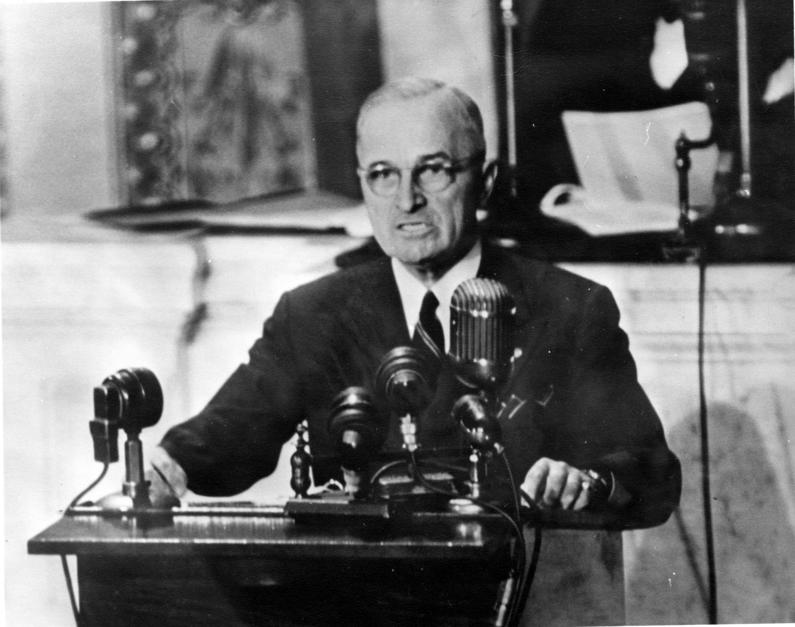 The Truman Doctrine – President
Truman addressing Congress – March 12, 1947
The Truman Doctrine – President
Truman addressing Congress – March 12, 1947
Harry S. Truman Library
and Museum
 Greek women mourning the
loss of their men and boys murdered by Communist guerrillas who came through their Macedonian
town – many killed because they had been seen talking to American military advisers
who had just come through the town – 1947
Greek women mourning the
loss of their men and boys murdered by Communist guerrillas who came through their Macedonian
town – many killed because they had been seen talking to American military advisers
who had just come through the town – 1947
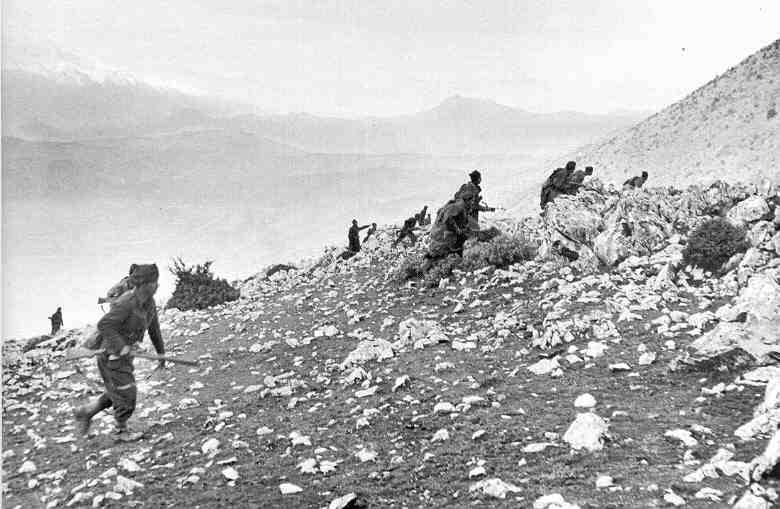 A Greek National Army patrol
sweeping toward the Albanian frontier in search of Communist guerrillas – early 1948
A Greek National Army patrol
sweeping toward the Albanian frontier in search of Communist guerrillas – early 1948
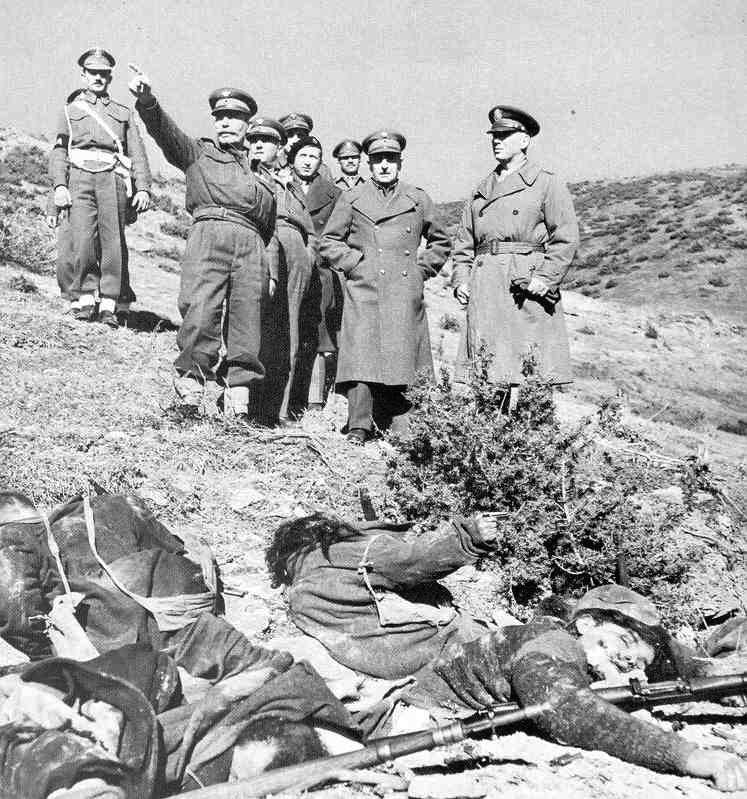
Greek Commanders and Lt.
General James A. Van Fleet, chief US military representative in Greece, standing over dead guerrillas
near the Yugoslav border – May 1949
MOUNTING PROBLEMS IN WESTERN EUROPE
... AND THE MARSHALL PLAN |
|
The effort to return Western Europe to normal life
Meanwhile, post-war Western Europe (Britain, the
Netherlands, Belgium, France, Italy, etc.) at first looked as if it
were actually going to rebound fairly quickly in its social and
economic life now that peace was at hand. There was much work to be
done, requiring the labor of soldiers returning to peacetime life, thus
preventing the danger of massive unemployment overwhelming their
post-war recovery.
But what permitted this post-war economic
rebound was the remainder of the financial credits held by the various
Western governments, which by the end of 1946 or early 1947 were
running out. Much of this government funding had ended up in America,
to purchase from America basic capital goods needed to restore the
destroyed infrastructure in housing, commercial and industrial
buildings, rail lines and docks. Local currencies were traded for the
dollars needed for these purchases. But by the winter of 1946-1947
Western European governmental financial reserves were drained dry. A
huge dollar deficit developed, bringing the post-war economic revival
in Europe to a halt.
Troubles in Western Europe
Workers were now being let go as businesses were
forced to shut down, causing workers to take to the streets in protest,
and driving many of them into the political arms of the fast-growing
Communist Parties (in France and Italy especially).
These were the kind of conditions that
could produce some very dangerous political mischief, as the politics
of the Great Depression had clearly demonstrated. In fact, the
Communist Parties in a number of Western countries were quite large,
constituting a third of the electorate in France and Italy, for
instance. Part of this was the by-product of the Great Depression, part
the friendly relations with Soviet Russia during the War, part of it
Stalin's strong direction of Europe's Communist movements throughout
Europe. After the war, under Stalin's direction, the French Communist
Party under Thorez and the Italian Communist Party under Togliatti
participated in the Leftist alliances with Socialist and Christian
Parties. The right-wing parties, identified in France with the
collaboration with the Nazis that took place during the Vichy regime
and in Italy with Mussolini's Fascist regime, were largely discredited
and were left out of all political affairs.
At this point it appeared that these
countries with large Communist organizations might be headed toward
Social Democracy (Marxism).
But by 1947 West Europeans were coming to
an understanding of Stalin's intentions to bring all of Europe under
Soviet mastery through his control of the large Communist movement in
the West, through workers' strikes which – though initially supposedly
addressing the problems of rapidly rising inflation and massive
unemployment – soon gave the appearance of being designed mostly to
paralyze the struggling economies of Western Europe. When in France
(May 1947) the Communists were then excluded from the coalition
government governing the country, the workers' rebellion grew even more
radical. Meanwhile the street violence in Italy was growing.
At this point Truman began to send aid
secretly to the anti-Communist labor unions and political party
organizations both in France and Italy.
Stalin responded to this challenge coming
from America with the resurrection of the old Comintern – the Communist
International organization which had been dissolved during World War
Two as a sign of Soviet good will toward Russia's Western allies –
making its new appearance in October of 1947 as the Cominform
(Communist Information Bureau), an alliance of Communist Parties around
Europe, all under Stalin's direction. Cominform membership included
also the huge French and Italian Communist Parties. Stalin clearly
intended to take a stronger hand in reshaping post-war Europe, West as
well as East. |
| In
Western Europe there is also a decided political shift to the Left
following the war. Worse, Leftist parties (principally the French
and Italian Communist Parties) seem to be taking orders from
Stalin directly. In France, the Communists
under Maurice Thorez are demonstrating significant political gains |
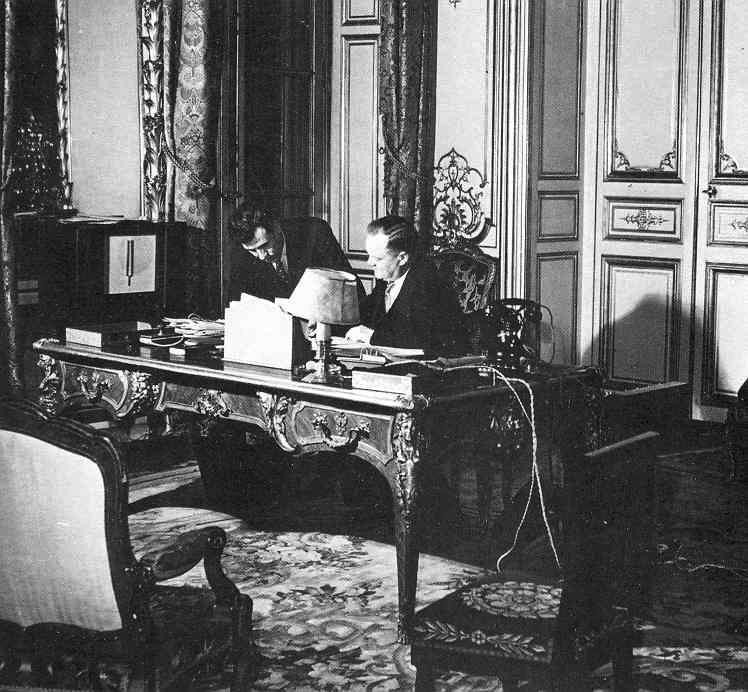 French Communist leader Maurice
Thorez (right), Vice Premier in post-war France – Dec. 1946
French Communist leader Maurice
Thorez (right), Vice Premier in post-war France – Dec. 1946
The same movement to the
Left is strongly registered in Italy
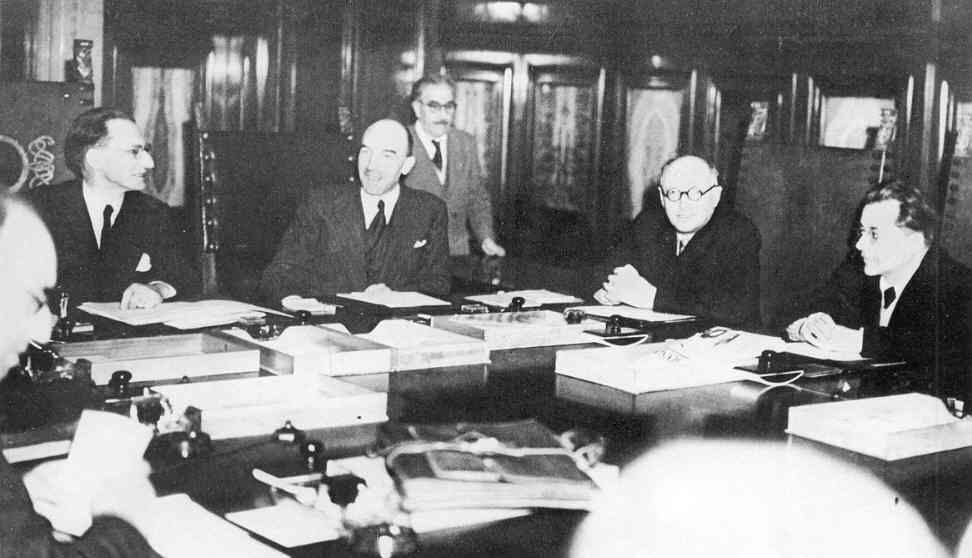
Italy's postwar political
coalition – and rivals: Christian Democrat Alcide de Gasperi (rear
left), Socialists Pietro Nenni
(third from left) and Communist Palmiro Togliatti (right) – Rome, December
1945
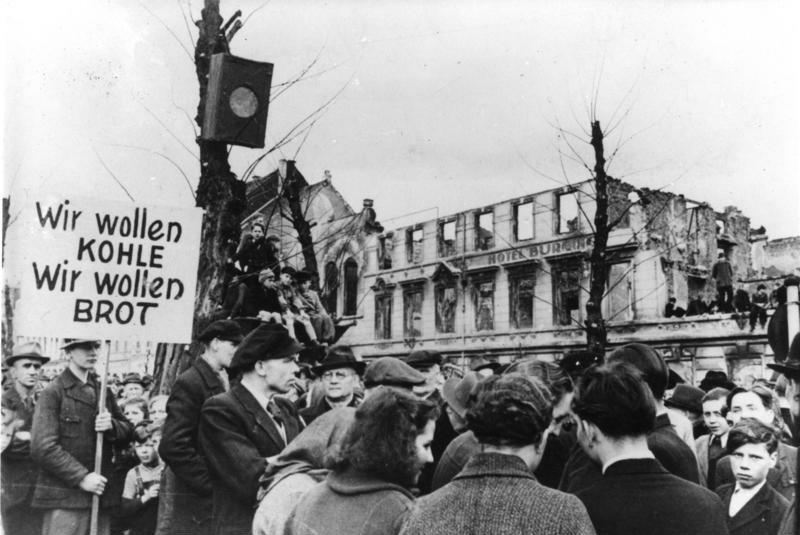 The long winter of discontent:
1946-1947. Citizens of Krefeld Germany protesting, in demand for food and fuel
(March 1947) The long winter of discontent:
1946-1947. Citizens of Krefeld Germany protesting, in demand for food and fuel
(March 1947)
Bundesarchiv
183-B0527-0001-753
In the Eastern European countries under direct Soviet military occupation, there
is no question about whether their future is "Communist" or not.
Tragically, Truman must simply leave those living under Soviet
occupation to their sad fate.
|

A Polish soldier oversees
Polish elections – January 1947
|
But Truman was as determined that Stalin
should not be able to do that. Truman was keenly aware of the immense
financial crisis Europe was facing – with all of its dangerous
political implications as it found itself running out of the funding
needed to get healthy economies back up and running again. Truman thus
worked out a plan to help Europe with its dollar shortage, by simply
extending huge dollar grants to the European countries to help get them
back on their feet. These were not loans. They were outright financial
gifts, ones that would be given freely as the European countries
submitted to America well-designed proposals for reconstruction. If
these programs seemed doable, then America would provide the financing
for the programs.
Thus it was that Truman's secretary of
state (former general), George Marshall, announced this plan at a
Harvard commencement speech in early June of 1947. And so it was also
that the world came to learn of the famous "Marshall Plan."1
All European countries (including even
former enemies Germany and Italy) were invited to participate in the
Plan. But the Russians saw this as a move that would put America at the
center of the European recovery. Consequently, Russia announced that it
would not be participating. It also became quite clear that neither
would they let any of the East European countries under their control
participate in the Marshall Plan.
Thus sixteen countries of West Europe gathered in Paris in July of 1947
to discuss the Marshall Plan, offering the Europeans billions of
dollars in grants – under the condition that they work together to
determine the way the funds were to be distributed. This was one of the
big objectives of the Plan, to get the Europeans to rebuild Europe
jointly, and not just separately as competing nations. Indeed, the
whole European side of the Plan was put under the multinational
Organization of European Economic Cooperation (OEEC), thus helping to
birth a new European unity movement.
1Truman
himself called for the Plan to go under Marshall's name, knowing that
Marshall had a much better standing than he did with the frugal
Republicans of Congress, who would have to approve the huge spending
that the Plan called for.
The Marshall Plan to Aid
Europeans in Building a Stable Europe
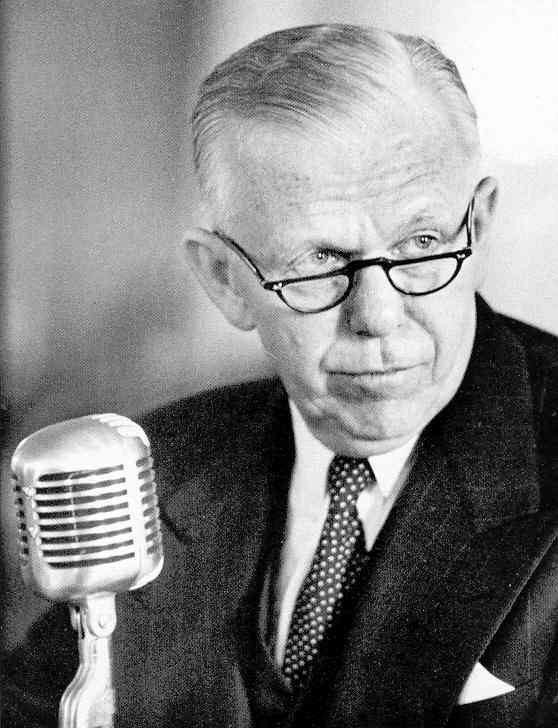 US Secretary of State (former
General) George C. Marshall explains to Congress details of the European Recovery Program (popularly
named the "Marshall Plan" after him) in January 1948
US Secretary of State (former
General) George C. Marshall explains to Congress details of the European Recovery Program (popularly
named the "Marshall Plan" after him) in January 1948

Marshall Plan food shipments
arriving in Europe
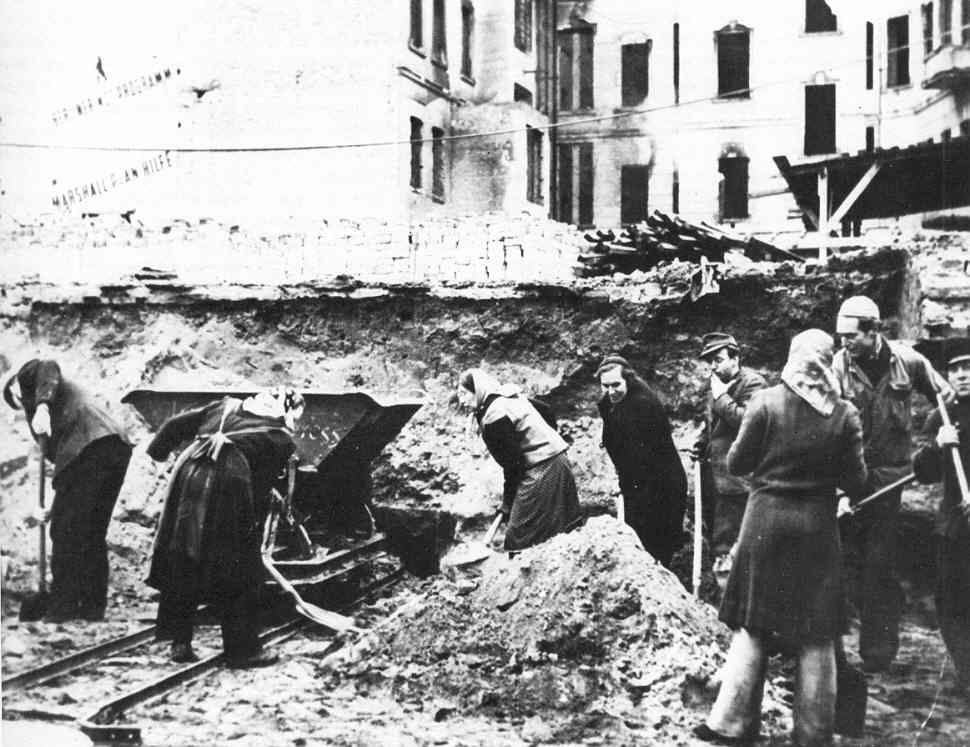
Paid by funds from the US
Marshall Aid Plan, Berliners are employed to clear rubble and begin
reconstruction
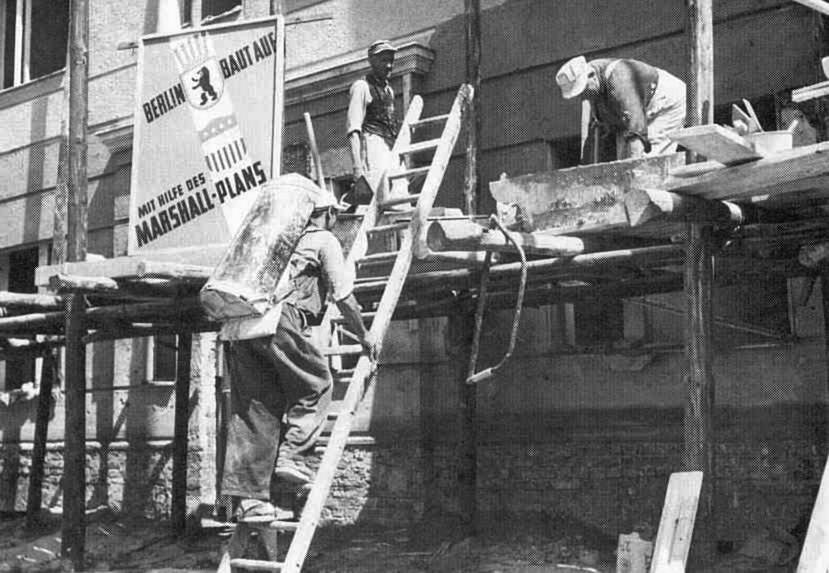 Marshall Plan aid working
to rebuild West Berlin
Marshall Plan aid working
to rebuild West Berlin
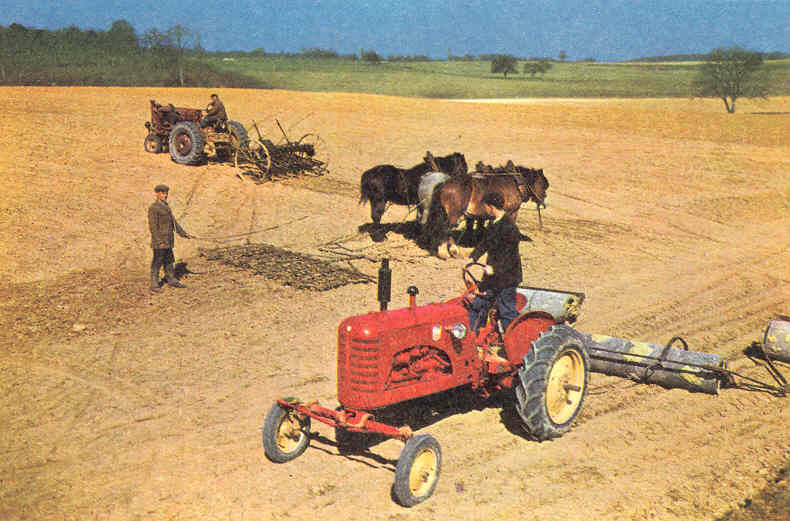 French farmer using a US
tractor sent under the Marshall Plan
French farmer using a US
tractor sent under the Marshall Plan
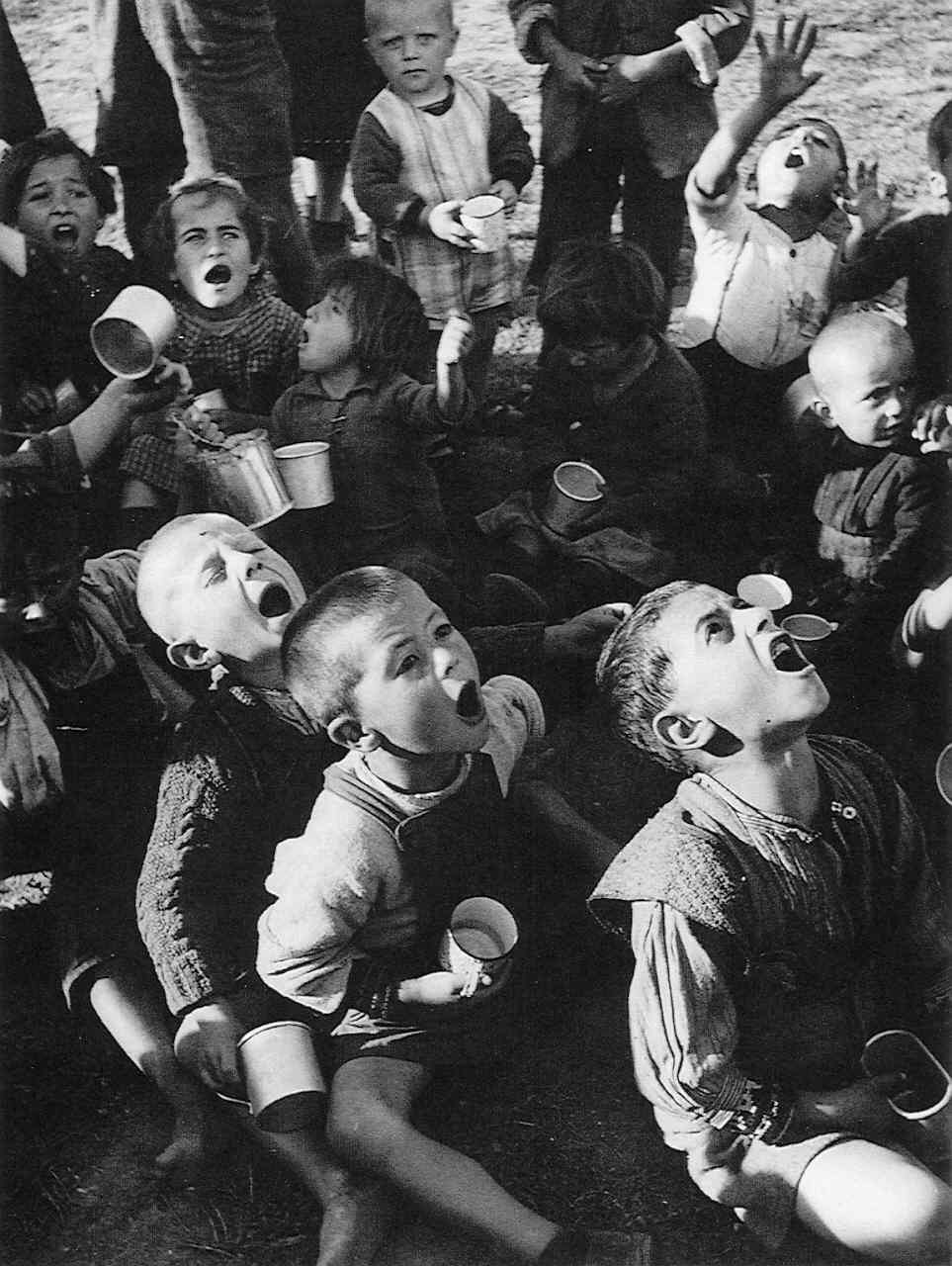
Hungry Greek children waiting
for their rations of powdered milk – 1948
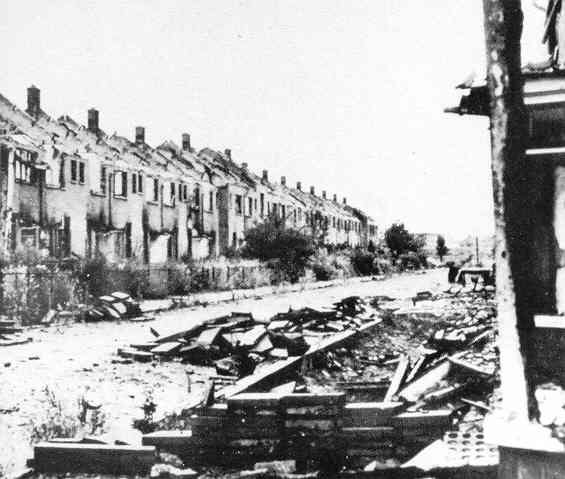
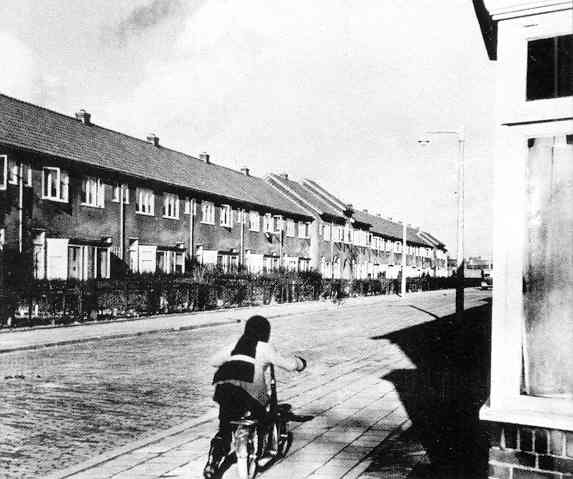 A Dutch street before and
after with the help of Marshall Plan assistance
A Dutch street before and
after with the help of Marshall Plan assistance
U.S. International Communications
Agency
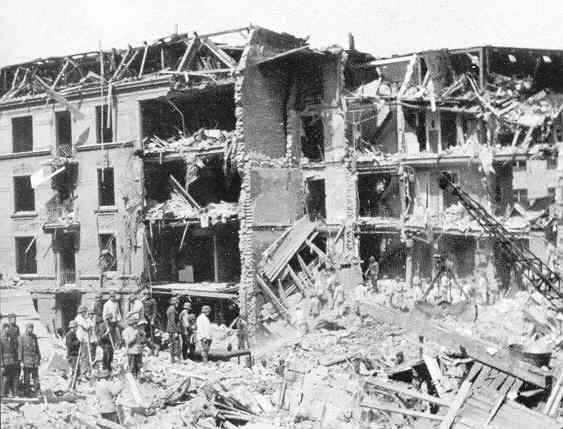
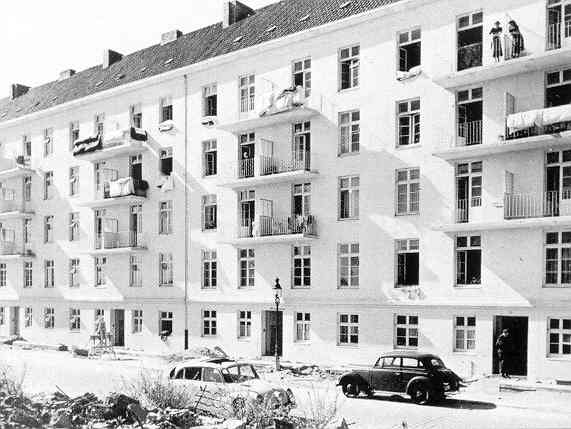 Hamburg apartment buildings
in 1943 and again in 1951 – with the help of Marshall Plan assistance
Hamburg apartment buildings
in 1943 and again in 1951 – with the help of Marshall Plan assistance
National Archives
THE SOVIETS TIGHTEN THEIR GRIP ON EASTERN EUROPE ... AND TAKE OVER CZECHOSLOVAKIA |
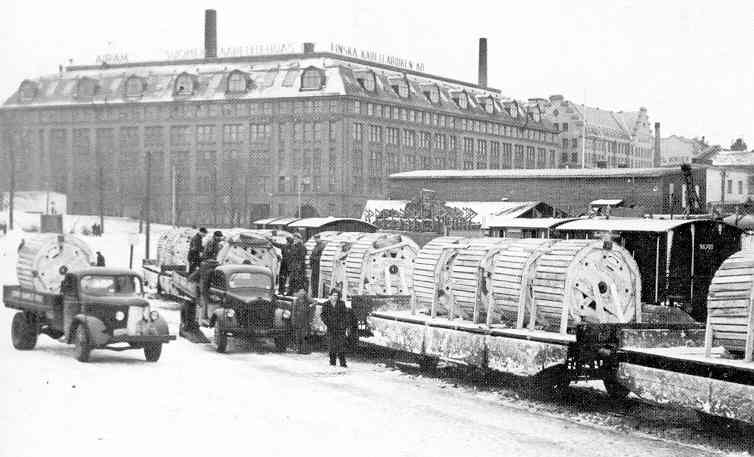 Electric cable being shipped
by Finland to Russia – 1948 – part of a $300 million
reparations obligation imposed on the Finns by the Soviets
Electric cable being shipped
by Finland to Russia – 1948 – part of a $300 million
reparations obligation imposed on the Finns by the Soviets
|
The Communist coup in Czechoslovakia
But if Truman was having difficulty in awakening
America to the growing danger to Europe and the West coming from
Moscow, an event that took place in early 1948 helped him immensely.
Czechoslovakia, or at least the Czech or western portion of the
country, had long been identified with the modern Western culture of
Europe. It had been a stable democracy before the war, and with its
former president, Edvard Beneš, back in the presidency after the war,
it appeared as if Czechoslovakia would retake its important place in
Western society.
But a number of major problems threatened
that possibility. First was the presence of the Russian Red Army on the
borders of the country, in a position to easily overrun Czechoslovakia
if Stalin decided to do so. Secondly, the Communist Party in the 1946
elections had gained 38 percent of the vote, making it the largest of
the parties in the country, though by no means itself a majority party.
It had been given a number of seats on the national cabinet (though not
a majority of them), but most importantly the premiership (Gottwald)
and the head of the armed forces and the national police. This would
prove to be most strategic for the Communists. Thirdly, the
Czechoslovak cabinet was talking openly about the possibilities of
participating in the Marshall Plan, something that Stalin opposed
strongly. And fourthly, President Beneš was a person who by natural
temperament placed kindly cooperation above all other considerations in
the running of his presidency (he had cooperated with Chamberlain back
in 1938 in agreeing not to use his army of forty well-armed and
well-trained divisions to oppose Hitler’s taking of Czechoslovakia’s
Sudeten borderlands – a huge mistake!). And fifthly, the Communists
looked like they were going to lose a lot of seats in the coming
mid-1948 elections because of a national backlash against their abuse
of their police powers (bullying political opponents, Nazi style).
As 1948 approached, the Communists knew
that they needed to do something bold before they got scooted out of
power. An intervention by the Red Army would likely only backfire
against them. So instead they intensified the use of their police
powers, removing the last of the non-Communist police officials
(despite the outcry of the country). At this point (February 1948) a
number of the non-Communist cabinet ministers offered their
resignations, hoping that it would force Beneš to finally take a firm
stand against the mounting Communist agitation in the government – and
in the streets. But Beneš, fearful of a Soviet military intervention,
accepted the resignations of the non-Communists and, under pressure
from Gottwald, appointed Communists in their place. Then the
Communist-directed police and military began the roundup of
non-Communist officials. Other cabinet members either resigned or bowed
to Communist authority, except Foreign Minister Masaryk, who was found
dead three floors below an open window – declared by the authorities to
be a suicide (actually records opened with the fall of Russias Soviet
government in the early 1990s revealed that in fact he had been thrown
out the window). Thousands of people were arrested, thousands more fled
the country. Then what was left of Czechoslovakian government lined up
behind the Communists, calling for the creation of a new Constitution
(May) – which the voters then approved by an 89 percent favorable vote
(like Hitler's plebiscites!). A vote at the end of May gave the
Communists an absolute majority in the parliament, and soon sole rights
to exist as a political party. At the beginning of June, Beneš resigned
as president, his place was taken by Gottwald, and in September Beneš
died, bringing symbolically Czechoslovakia's democratic era to an
official end. It would be forty years before Czechoslovakia would see
national freedom again.
|
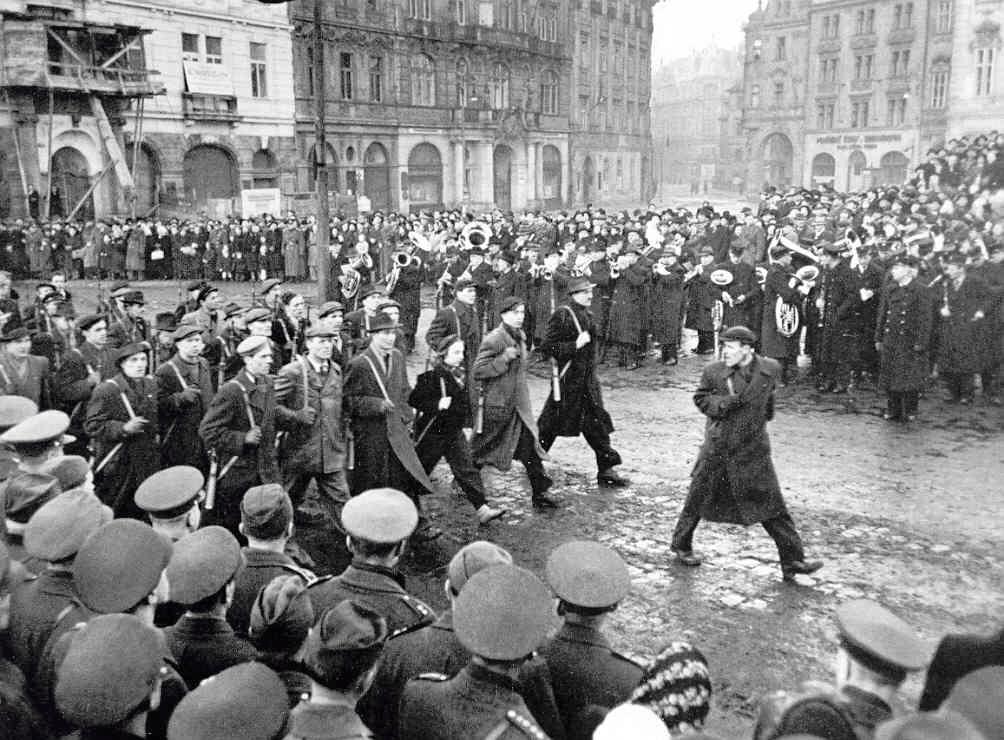
Armed Czech Workers' Militia
who bullied non-Communists into submission marching through Prague
in celebration of the new Communist government ruling
Czechoslovakia
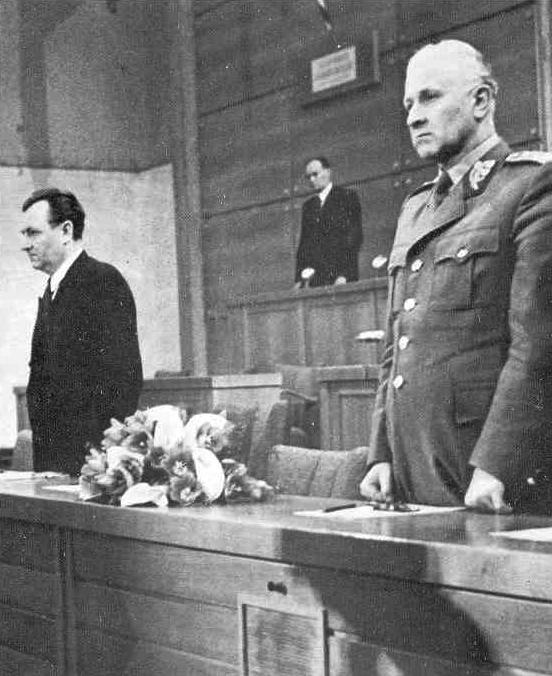 Pro-Western Foreign Minister
Jan Masaryk honored by floral wreath and minute of silence by Communist Premier Klement
Gottwald (left) and Defense Minister Ludvik Svoboda
Pro-Western Foreign Minister
Jan Masaryk honored by floral wreath and minute of silence by Communist Premier Klement
Gottwald (left) and Defense Minister Ludvik Svoboda
HELPING TITO MOVE OUT FROM UNDER STALIN'S CONTROL |
Despite the "Red Scare,"
East-West ideological lines have not yet hardened in America to the point where Truman
can't help Communist leader Tito stay free of Stalin's control
|
Helping Tito's Yugoslavia preserve its independence
Westerners were shocked by the Communist takeover
in formerly free Czechoslovakia ... including finally the
Americans. Truman of course was not. Nor did he come to the same
sense of alarm as did the newly awakened Americans. In America
the Czechoslovakian crisis succeeded in reviving an old Red Scare, one
that would shape nearly all understandings of America's role in the
world for the next generation.
Truman saw things a bit differently. He
certainly understood the challenge that Marxist ideology posed to the
values of Western democracy. But he was more interested in how this
challenge directed political behavior of specific societies, in
particular Stalin's Russia. Truman was more interested in power
politics than in grand ideology. He was thus able to carry off a highly
advantageous diplomatic move, one that within a couple of years would
have been impossible, given the rising ideological mood of America.
This diplomatic move concerned Tito's Yugoslavia.
During World War Two Josip Broz Tito had
headed up a huge military unit of Communist Partisans that gave the
Germans a massive amount of trouble in Yugoslavia. In early 1945, as a
full German defeat looked increasingly likely, Tito took charge of a
new provisional government debating the question of forming a new
republic or continuing the monarchy under the young King Peter II. In
elections held in November of 1945, the pro-monarchists largely
boycotted the event, delivering a huge victory to Tito's
pro-Republicanists – dominated heavily by the Communists, who had
achieved a very high moral standing among Yugoslavia's various ethnic
groups because of their dedication to ousting the Germans from the land.
Though Tito was a loyal Stalinist, he was
also an independent thinker, and had specific plans of his own for
Yugoslavia. Those plans included incorporating all of the Trieste
territory to the northwest of the country (including shooting down
American planes supplying Trieste with aid) plus building his own
diplomatic alliance with the Greek Communists to the south. This upset
Stalin greatly because he was afraid that Tito's activities would call
forward a strong American response (which it did), Stalin having come
to appreciate the strengths of the new American leader, Truman.
Tito also had his own ideas of how he wanted to unite economically the ethnically divided Yugoslavia.
Such independent-mindedness annoyed
Stalin greatly, as he wanted all Communist organizations to function
under his sole authority. Problems between Tito and Stalin thus began
to develop.
Ultimately, Tito refused to attend the
second meeting of Stalin's new Cominform held in June of 1948,
expecting to be verbally attacked by Stalin. Stalin was furious at this
affront and called for Tito's expulsion from the Cominform, Stalin
expecting his personal disapproval to be the undoing of the
independent-minded Tito. When expulsion did not seem to have the
desired effect, Stalin took up his more usual program of seeking to
eliminate any who dared to oppose, or even question, him. None of
Stalin's efforts succeeded however. Tito in turn now went after any
supposed Stalinists in his own country, arresting thousands.
This turn of events opened the way for
Tito to access America's Marshall Plan (1951). Receiving American
financial (and also some military) support did not exactly align Tito
with the growing Western diplomatic alliance headed up by America. But
it effectively made Yugoslavia an openly neutral or non-aligned country
in the Cold War. Indeed, Tito went on to be one of the key leaders of
an international movement – at the time principally among Asian states
– which declared itself to be aligned with neither the West nor the
East. These non-aligned countries saw themselves as comprising a new
"Third World."
Truman was not looking for Yugoslav
loyalty in his swing of economic support behind his former adversary.
What Truman did achieve through this support of Communist Yugoslavia
was keeping Stalin from acquiring Yugoslavia as another satellite
state, one particularly that might have given Stalin the opportunity to
extend his political reach all the way to the Adriatic Sea just
opposite Italy and thus also a position on the Mediterranean Sea, a
goal long sought by the Russians. In supporting the Communist Tito,
Truman had contained Stalin. That loomed in importance much larger in
Truman's mind than the idea of opposing Communism, no matter where it
showed its head, for such ideological crusading would have helped drive
Tito back into Soviet hands, the very thing sought by Stalin.
This was cool-headed thinking on the part
of Truman, something unfortunately that would be lost on the vast
majority of Americans – who at this point were beginning to see things
in absolute Black-White (or Red-White!) dimensions.
|
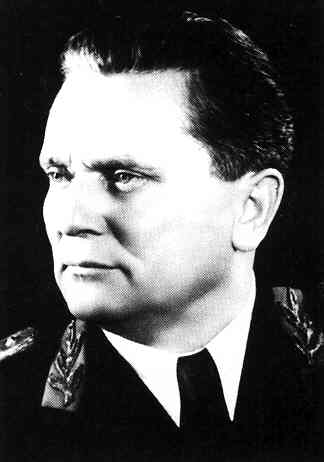 Marshal Tito (Josip Broz)
- Communist, but anti-Soviet, President of Yugoslavia
Marshal Tito (Josip Broz)
- Communist, but anti-Soviet, President of Yugoslavia
Library of Congress
THE BERLIN BLOCKADE (1948-1949) MAKES THE RUSSIAN COMMUNIST CHALLENGE IN EUROPE OBVIOUS TO ALL |
|
The Berlin Blockade and Airlift (June 1948-May 1949)
Stalin's expectations at war's end were that the
Western occupation of parts of the Berlin capital city would not last
more than a year or two. But it became increasingly clear over the next
couple of years that the French, British, and Americans were planning
to stay in place in Berlin until the country was fully reunited and all
German occupation zones were vacated by the wartime Allies. Annoyed by
this resistance, Stalin began to put pressure on Berlin by ceasing to
deliver agricultural goods to the city, which in turn caused the Allies
to suspend the shipment from their zones of German industrial machinery
to the Russians. Meanwhile Berliners in the municipal elections were
turning sharply against the Communists, concerning Stalin greatly.
Stalin knew that somehow the Western Allies had to be driven from
Berlin.
To make matters worse for Stalin, the
Western Allies were holding talks in early 1948 about uniting their
three German occupation zones into a single political unit, thus
creating a Federal Republic, complete with its own currency, the
Deutsche Mark, this new Germany also eligible to receive Marshall Plan
funding.
This was the signal for Stalin to shut
down the West’s access to Berlin by way of the rail, highway, and canal
routes which passed through the Soviet-controlled East German zone. The
program started off sporadically at first, the Soviets probably testing
the resolve of the Western Allies. But the Allies responded by
airlifting supplies into Berlin. Then the Soviets eased off their
restrictions, for a while at least, although they harassed the flights
in and out of Berlin (causing a major mid-air crash in April). Finally
in late June with the introduction of the new Deutsche Mark (in West
Berlin as well as the rest of the country) the Russians acted to shut
down completely all land access into Berlin, leaving only air access to
Berlin – but estimating that any such continuing air supply to Berlin
would prove financially ruinous to the Western Allies. On this point
they miscalculated greatly the resolve of Truman not to be bullied out
of Berlin. Berlin and its outcome thus became a symbol of strength and
determination, for both sides of this new contest.
Militarily the Westerners were vastly outnumbered. Soviet military
forces positioned in the Soviet zone numbered about 1.5 million. In
Berlin itself there were only less than 23,000 Western troops, and in
West Germany as a whole less than 100,000. If the Russians decided to
simply grab Berlin, there would have been no way of stopping them. But
that would have constituted an act of war, and the fact that America
now had numerous quite deliverable atomic bombs – and a president
proven willing to use them – caused Stalin to head off any idea of a
shooting war. The idea of shooting down unarmed supply planes was for
the same reason something Stalin knew he could not let happen. But he
believed that he could simply wait out the Westerners, resulting in
their eventual loss of Berlin, and in the process gain a great symbolic
victory. This would then ultimately impress all of Germany with the
idea of who truly ruled in central Europe. Winter was coming and surely
the very expensive airlift would have failed by then.
But the Western airlift by the Americans
and the British was an impressive display of Western resolve, and
Western power. Through the winter the airlift continued, bringing in
more food and fuel than had been brought to the city previously by the
land routes! Also a December 1948 municipal election boycotted by the
Communists led to a complete victory for the pro-Western candidates,
effectively ending the idea of an all-Berlin city government – the
Communists responding by setting up a government of their own in the
Soviet sector of Berlin. Like Germany, Berlin was now divided into two
cities, East and West Berlin. Movement between the two sectors still
continued (ending only with the building of the Berlin Wall in 1961).
But there was now truly an East Berlin and a West Berlin.
The Soviets were gaining nothing by this
maneuver, instead throwing a lot of political advantage to the West.
The French, British, and American sectors found good reason to put
aside any tactical disagreements and work together more closely. The
blockade also inspired the rapid development of the German Federal
Republic. And it impressed the Germans very favorably toward their
French, British and American occupiers who appeared to them more as
their deliverers rather than their occupiers. On the other hand it made
the Russians appear more to be the oppressors of Germany.
And it stirred great sympathy from the Americans for their former German enemies.
Finally in May of 1949, the Soviets
indicated a willingness to end the blockade. The two sides met and the
blockade was lifted. But the bringing of supplies into Berlin by air
continued, just in case. By July the Allies had built up a 3-month
reserve of supplies in Berlin just to send a message to the Soviets to
not ever again try to squeeze the Westerners out of Berlin.
|

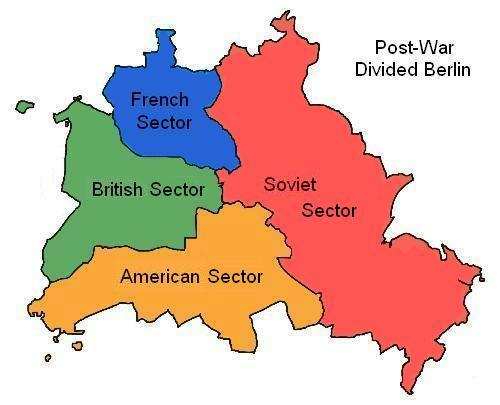 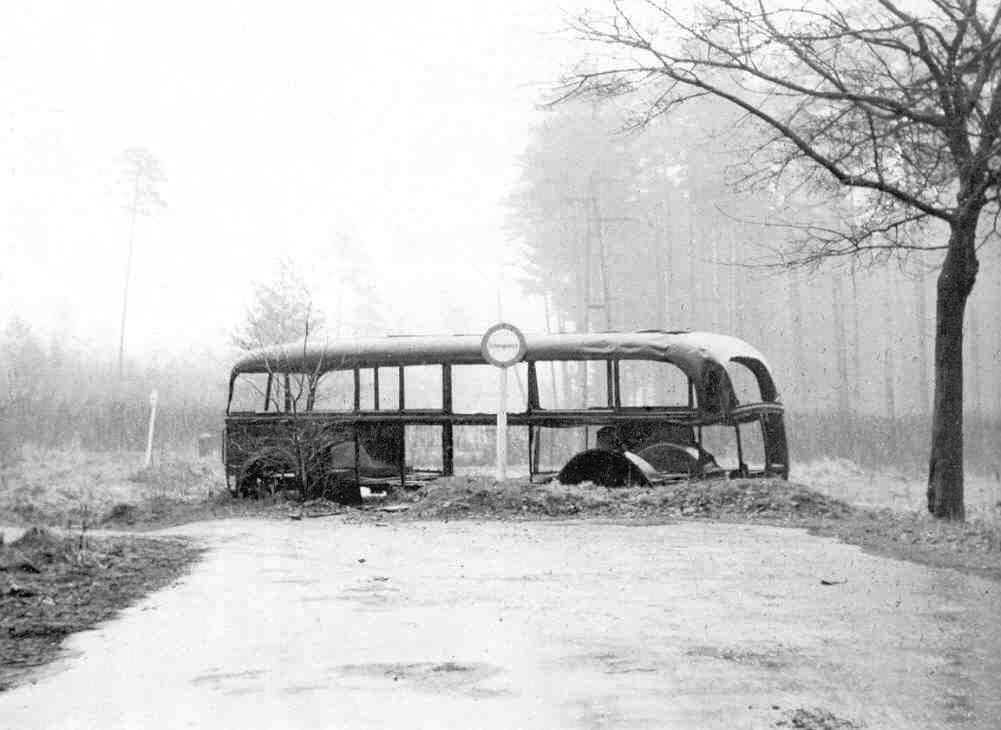
A bus used as a roadblock
across a major highway from the West into Berlin
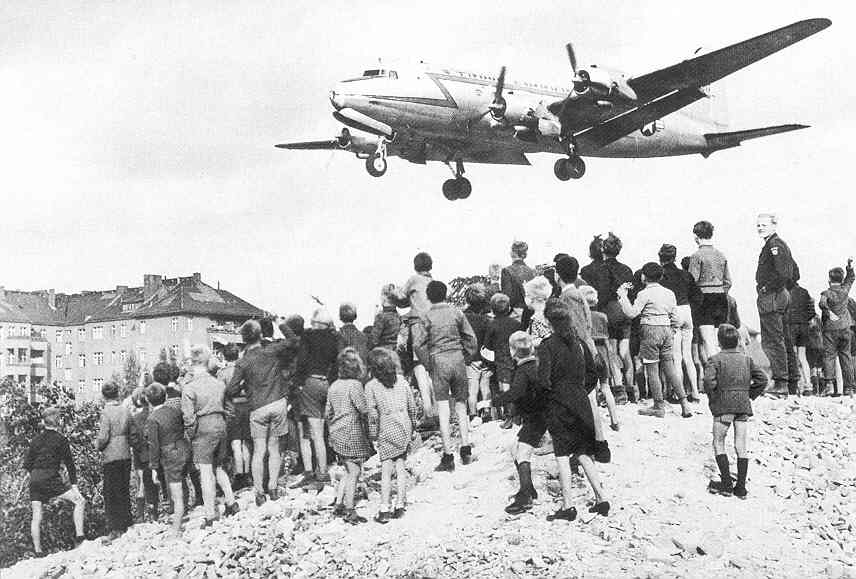
The Berlin Airlift – 1948 – 1949
United States Air Force
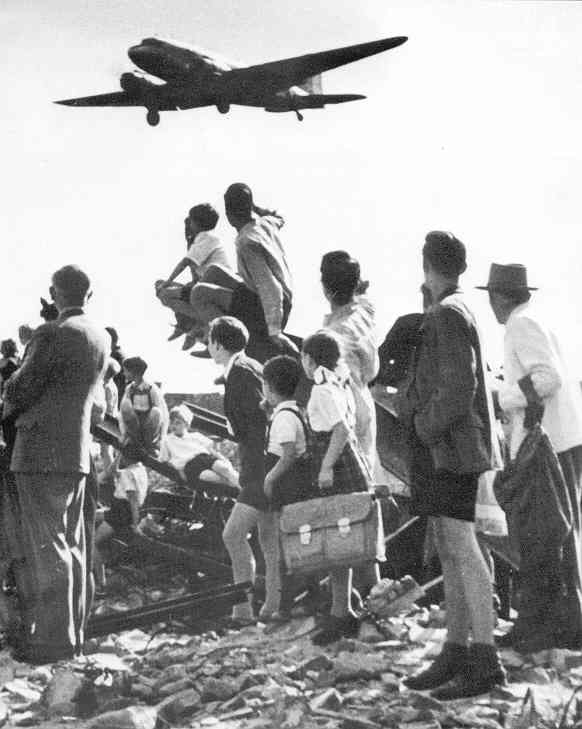
The Berlin Airlift – 1948
- 1949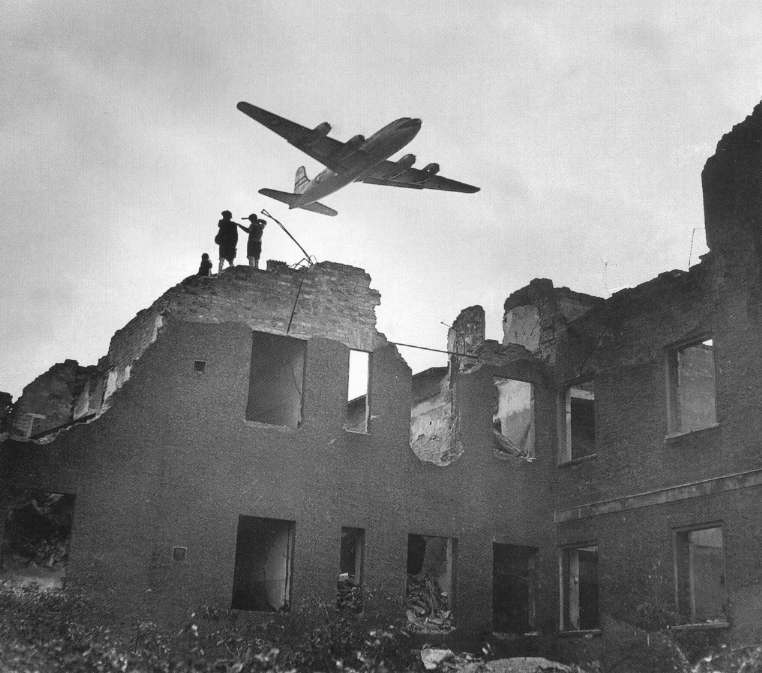 US planes airlifting supplies
into Berlin during the blockade of the city by Stalin
US planes airlifting supplies
into Berlin during the blockade of the city by Stalin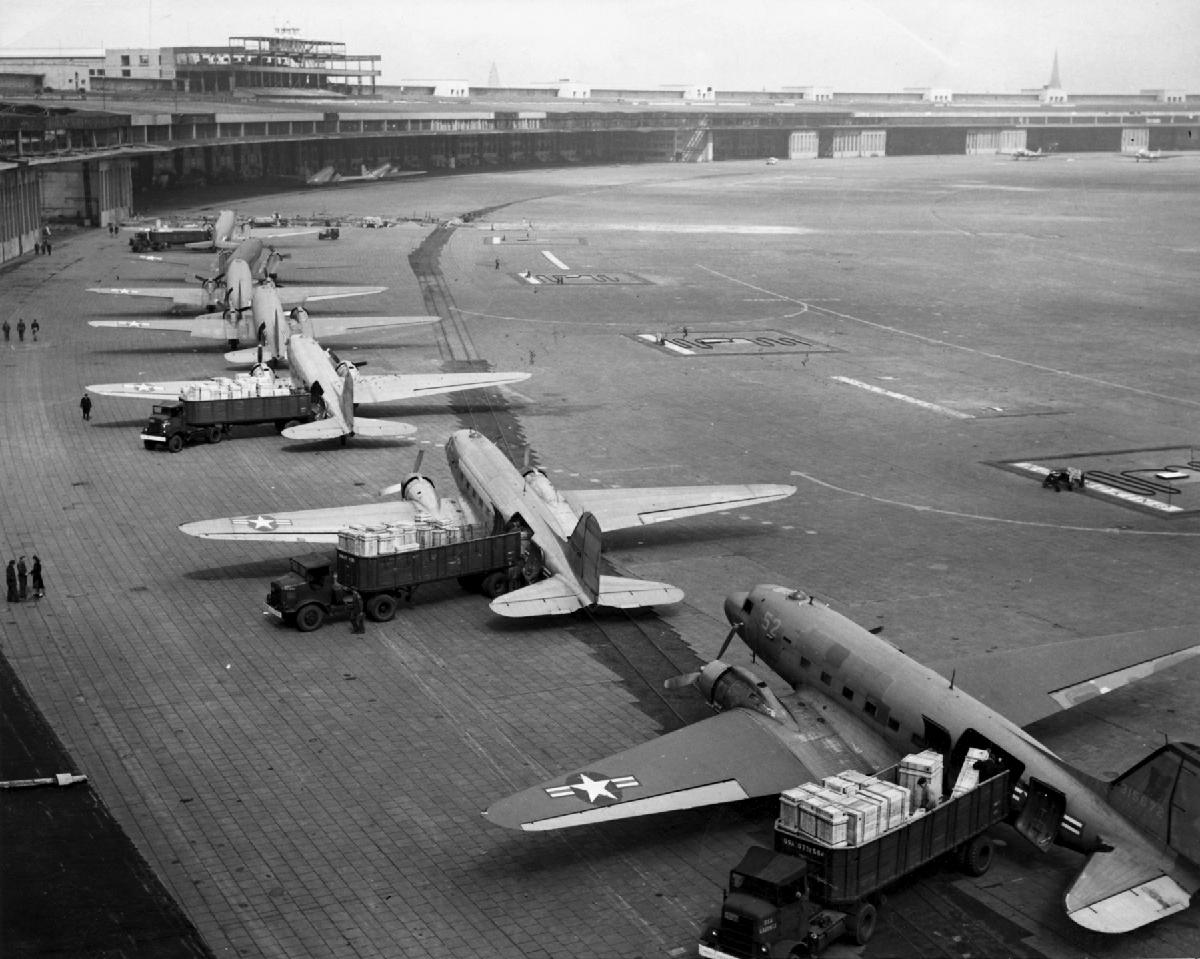
Unloading US planes at Tempelhof
in Berlin
United States Air
Force
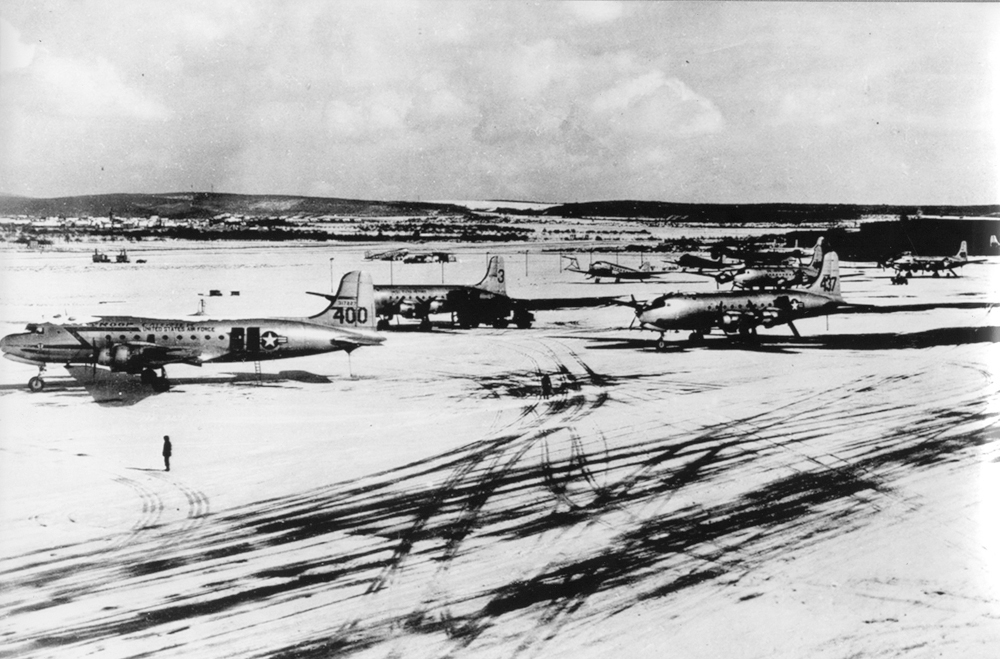
US C-54 cargo planes at snow-covered
Wiesbaden Air Base during the Berlin airlift – March
1949
United States
Army
THE INEFFECTIVENESS OF THE U.N. ... AND THE CREATION OF NATO |
|
The increasingly apparent ineffectiveness of the new United Nations
So much had been said at its birth in the last
days of the war – about the way the new United Nations Organization was
going to help establish a secure and lasting international peace – that
expectations ran high in America that finally a formula for preventing
the further outbreak of war (of which Americans had experienced two in
just that many generations) was now no longer a serious danger. Yet,
the major crises that America already found itself facing in the days
and months since the end of the war in no ways seemed to have involved
the United Nations in a constructive way. Was the United Nations just
another one of those fancy dreams sold to the American people by
Idealists, Idealists that had no serious grounding in political
reality? Was the United Nations all just a waste of time and money?
How much Truman had really expected by
way of Russian cooperation in the functioning of the United Nations is
hard to say – though it probably was not much. Americans, however,
became increasingly incensed that the Soviets kept vetoing measures in
the United Nations Security Council (the only part of the United
Nations where forceful international policies could be ordered). Each
Soviet veto was viewed by the Americans as a measure of depravity of
the Soviet position.
Actually, it was the natural response of
a major power that sensed that the vast majority of the members of the
United Nations were for the most part American allies of one sort or
another and thus pretty much lined up against Soviet political
interests everywhere. The Soviets might have wanted to pull out of the
organization altogether but did not, figuring that it was better to
stay in the organization where the Russians at least had veto power,
than to leave the organization to the Americans to rally the rest of
the world in opposing Soviet political interests. Thus the vetoes.
But this meant that American diplomacy
would have to look elsewhere than the United Nations in order to build
a world of peace along lines more favorable to the interests of America
and its West-European allies.
Thus, on April 4th, 1949, some twelve
nations met in Washington, D.C. to sign the North Atlantic Treaty, a
military treaty that bound together the members of this treaty on a
one-for-all / all-for-one basis: America, Canada, Iceland, Great Britain,
Norway, Denmark, Portugal, Italy, France, Belgium, the Netherlands, and
Luxembourg. For America this was a first: a peacetime military alliance
binding the country to the defense of Europe (actually the defense of
any member, including Canada and Iceland). What inspired this was a
combination of actions already taken among some of the European nations
themselves, plus the crisis of the Berlin Blockade.
The British, French, Dutch, Belgians, and Luxembourgers had already
entered into a similar military agreement in March of 1948 (the Treaty
of Brussels), although that agreement was designed as much as a mutual
defense against a revived Germany as it was an anti-Communist or
anti-Soviet alliance. Then in September of 1948 the treaty members set
up an actual joint military command structure, the Western Union
Defense Organization.
A second piece in the creation of the
North Atlantic Treaty was the political groundwork laid out at home to
get America to join a peacetime military alliance. Here is where the
Berlin Blockade was of great assistance in the effort. But it is
important to note that by 1948 Arthur Vandenberg, the Republican
Chairman of the Senate Foreign Relations Committee (which must confirm
all American treaties), who had once been an ardent isolationist, had
become an equally ardent internationalist, supporting strongly the idea
of American leadership in a post-war Free World. Talks between
Vandenberg and Marshall's Assistant Secretary of State Dean Acheson and
Deputy Secretary of Defense Robert Lovett early in 1948 had touched on
the idea of a North Atlantic military alliance. Vandenberg agreed to
put the matter before the U.S. Senate in May of that year, in the form
of a resolution, to be debated and hopefully supported by the Senate,
clearing the way for America to enter just such an alliance. And indeed
in June the Senate overwhelmingly (eighty-two to thirteen) approved the
Vandenberg Resolution. And thus resulted the gathering in April of 1949
in D.C. of the representatives of the twelve nations to sign the North
Atlantic Treaty.
Very soon a crisis which broke out the
following year (1950) in far off Asia – the Korean War – pushed the
Alliance to take the next step and put into place an actual
organization integrating the contributions by the member nations to the
various military commands, so as to give the Alliance great strength of
unity. Thus out of the North Atlantic Treaty quickly came the North
Atlantic Treaty Organization (NATO). Immediately work began to put
together a number of military divisions (the plan was originally for
ninety-six such divisions, but dropped down in target to thirty-five
divisions) soon to be headed up by General Eisenhower as NATO's Supreme
Allied Commander, working out of the Supreme Headquarters Allied Powers
of Europe (SHAPE). The organization itself would be headed up by a NATO
secretary general – the first being Churchill’s primary wartime
military assistant, Lord Ismay.
|

Go on to the next section: Post-War Asia
 Miles
H. Hodges Miles
H. Hodges
| |


 Truman takes on early global challenges
Truman takes on early global challenges
 The mounting sense of a Soviet or
The mounting sense of a Soviet or Crisis in Greece and Turkey ... and the
Crisis in Greece and Turkey ... and the Mounting problems in Western Europe ...
Mounting problems in Western Europe ... The Communist coup in Czechoslovakia
The Communist coup in Czechoslovakia
 Helping Tito move out from under
Helping Tito move out from under The Berlin Blockade (June 1948 – May
The Berlin Blockade (June 1948 – May The ineffectiveness of the UN ... and the
The ineffectiveness of the UN ... and the






































